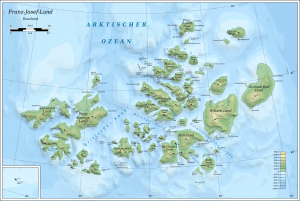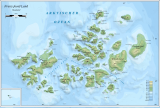Wilczek Island
| Wilczek Island | ||
|---|---|---|
| Map of the Franz Josef Land | ||
| Waters | Arctic Ocean | |
| Archipelago | Franz Josef Land | |
| Geographical location | 79 ° 56 ' N , 58 ° 42' E | |
|
|
||
| length | 11.5 km | |
| width | 9.8 km | |
| surface | 50 km² | |
| Highest elevation | 187 m | |
| Residents | uninhabited | |
| Location of Wilczek Island | ||
The Wilczek Island ( Russian остров Вильчека , Ostrow Wiltscheka ) is the zweitsüdlichste island of Franz-Josef-Lands (located south only the Lamont Island ) in the Arctic Ocean and also the first island that the Austro-Hungarian North Pole Expedition entered. It should not be confused with Wilczek-Land , the second largest island in the same archipelago. Both islands are named after Johann Nepomuk Graf Wilczek . The surface of the twelve-kilometer-long Wilczek Island is covered with ice. As everywhere on Franz-Josef-Land, you can also find polar bears on her .
history
On November 1, 1873, the newly discovered land was set foot for the first time. Was built on the Wilczek Island an approximately 100 centimeters high Steinmann and left a message to the world public about the new discovery in it. The letter was deposited in a barrel and then covered with stones. On August 5, 1991, the Dagmar Aaen reached Wilczek Island with Arved Fuchs as the first western ship. The ICESAIL Fuchs expedition found the stone man and the grave of the only victim of the Payer-Weyprecht expedition , Otto Krisch . Arved Fuchs removed the stone pyramid and came across the more than 100-year-old document, which, however, was no longer legible. It was only through the extensive work of the Federal Criminal Police Office in Wiesbaden that it became possible to make the document legible. It actually came from the polar explorers Julius Payer and Carl Weyprecht and is now in the German Maritime Museum in Bremerhaven .
On August 5, 1991, Arved Fuchs also placed a document (three A4 pages) tightly closed in a plastic bottle in the Steinmann, in the upper third. The Steinmann was closed over the message in a bottle and Arved Fuchs remarked in his diary: “We are rebuilding the Steinmann exactly as we found it. Finally, we deposit a bottle in the upper part with a note about our ICESAIL expedition and then finally close it. Who knows when the next visitor will come by ... ” The Fuchs expedition could also have gotten into trouble, and search teams would then have found the right lead through this message in a bottle.
In 2004, Helfried Weyer searched Wilczek Island for a day together with Reinhold Messner in vain for the Krisch grave. Messner came to the conclusion that both no longer exist, neither the Steinmann nor the Krisch grave. But Weyer did not give up and traveled again with a Russian icebreaker to Wilczek Island. He found the grave and the stone man, and the Russian Konstantin Pankov, part of the icebreaker's crew, came across a gray plastic bottle that was lying in the snow and had been bitten by a polar bear 250 meters away from the stone pyramid.
In April / May 2005 the Payer-Weyprecht memorial expedition was carried out with a special entry permit on Franz-Josef-Land. The modern small expedition, consisting of the Austrians Christoph Höbenreich (expedition leader) and Robert Mühlthaler, the Russians Viktor Bojarski and Nikita Ovsianikov and the polar dog Nanuk, started on the island of Wilczek and crossed Franz-Josef-Land on skis and sledges in the footsteps of Julius Payer to pay tribute to the historic achievement of the pioneers.
literature
- Julius Payer: The Austro-Hungarian North Pole Expedition in the years 1872–1874, together with a sketch of the second German North Pole expedition 1869-1870 and the polar expedition of 1871 . With 146 illustrations (wood engravings) and 3 (folded) maps. Hölder, Vienna 1876. CIV, 696 pp.
- Christoph Höbenreich: Expedition Franz Josef Land. On the trail of explorers to the north . Expedition picture book about the Payer-Weyprecht-Gedächtnexppedition 2005, the Austro-Hungarian north polar expedition 1872–1874, the polar journey of the icebreaker Kapitan Dranitsyn 2006 with a comprehensive expedition chronicle, Verlag Frederking-Thaler, Munich 2007, ISBN 978-3-89405-499-1
- Johann Jakob Egli : Nomina geographica. Language and factual explanation of 42,000 geographical names of all regions of the world. , Friedrich Brandstetter, 2nd edition Leipzig 1893, p. 1001 f.



